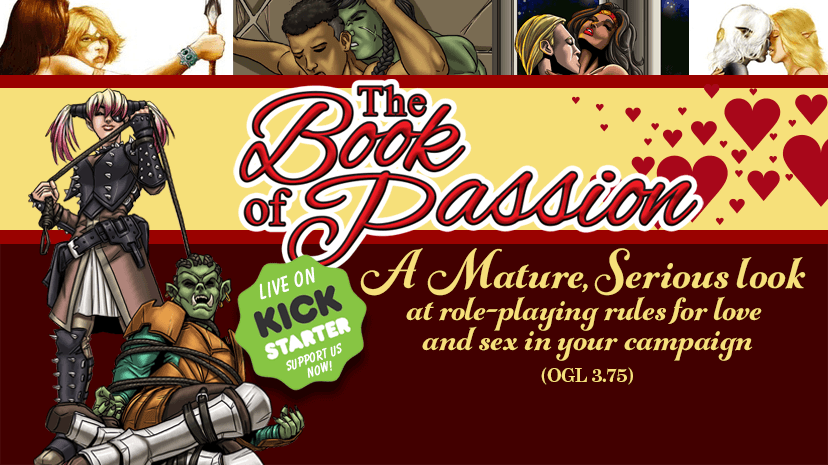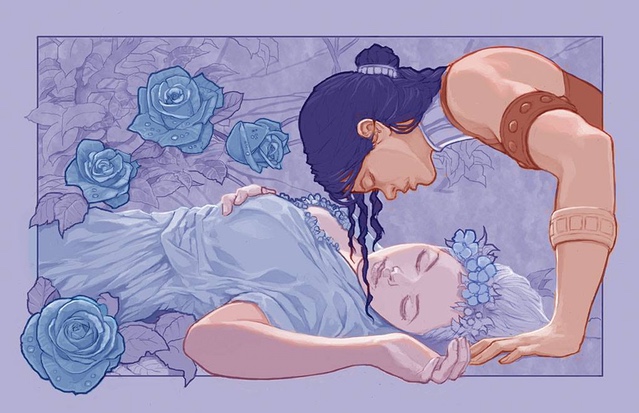With all the love and lust going around last week, on account of it being Valentine’s Day on Tuesday, you might have missed a new Kickstarter from Christina Stiles of Misfit Studios, The Book of Passion. The project is seeking support to publish a book about love and sex for the OGL 3.75 ruleset.
Regular readers who’ve read some of my older posts will know I don’t shy away from adult themes in my games. I believe there is a time and place for these topics, with the right group, and of course if everybody is comfortable with them. I would never try to alienate or hurt the sensibilities of my players. At least I try not to! Perhaps I’m lucky in that I play with my close friends, and since most of us have known each other for so long, we know where and how far we can go.
A project such as this will of curse be compared to the Book of Erotic Fantasy. I own a copy of it, and remember the controversy and hoopla around it. Much ado about nothing if you ask me! As you can tell I am definitely the target market for this new project. Not to brag, but I was the 2nd backer of the project. Fully believing that there should be a place for a product that tackles these subjects responsibly and respectful, and in my desire to spread the word about the book, I contacted Christina Stiles, the editor and publisher; she told me how to contact the authors. Margherita Tramontano and Will Wells were kind enough to grant me an interview, and over FB Messenger we had a LONG discussion about the book they have written together and may other topics. I thank them both for their accessibility and time.
I’d be remiss not to mention that both authors did an interview for The Other Side blog with Tim Brannan. I’ll try not to retread too much of what they covered there, except from some obligatory introductory stuff. Be sure to check out that interview as well. As mentioned above, the following interview is compiled from a rather lengthy conversation in FB Messenger, I edited the text of that conversation and some bits and pieces were moved around for clarity. Hopefully I kept the spirit of what they both meant, if anything seems odd or out of place, blame it on my editing, not on them! Now without further ado, my interview with Will and Margherita:
Sunglar: Hello Margherita and Will. First obligatory question, so the readers can get to know you better, what can you tell me about the two of you? Any project our reader may know you from?
Margherita: Well, I’m an Italian literature teacher, a geek, a would-be fantasy novelist, and a mum of two terrible and adorable little boys. I began with some articles on various issues of the Wayfinder fanzine. My first paid work was a template for Green Ronin’s Advanced Bestiary. Owen Stephens was the editor of that book, and put me in contact with Christina. We began to talk about this project as far as three years ago!
Sunglar: So, this has been in development for a while, good!
Margherita: I had met Will on a thread on the Paizo boards in 2011! We began to create stuff together, then we had the book’s idea.
Will: That story begins with the playtest for the Advanced Player’s Guide. I loved the Oracle class, and looked forward to seeing the full range of mysteries for it. Specifically, I was looking forward to a mystery for Calistria, my favorite goddess from the Pathfinder setting.
When the book was released, I excitedly waited for the delivery of my preorder copy. When it arrived, the first thing I did was open to the Oracle – only to find no new mystery for Calistria (there were a couple of other new mysteries, but none for her). In fact, I think she was the only Core deity with no associated mystery (although I could be wrong about that).
I was hugely disappointed. So much so that I decided to create my own mystery for Calistria. I did so, using the existing mysteries as examples to make sure I kept things balanced, and once I was satisfied with the results, I posted the Passion Mystery on the Paizo forums in the homebrew section.
Margherita: I was searching for a way to convert my novel’s AD&D 2E characters to Pathfinder. With some of them it was easy, some were very tricky. I had a Priestess of a Specific Myth with the Soothing Word power (very important, since she used it to keep at bay her cursed berserker friend) and I couldn’t find a way to convert her. She had to possess some druid spells, be able to permanently suppress rage, and be unable to plane shift. An oracle seemed a better fit than a cleric, but a Life oracle was not enough. I found Will’s notes and enjoyed them. So, I gave him some advice… and before we knew, we began working together. He asked if I would like to make a Sailor Senshi oracle archetype, and I made it. Then we moved to other classes. One day, we began to think about a book. I sent our manuscript to Christina, and now, here we are.
While I was working on this, I published some things with Flaming Crab Games (material for Here There Be Tiny Dragons, Her Story, Hygiene, and Dinosaurs Companions), The Knotty-Works (the Esotericist), and a couple of Everyman Minis (Childhood Feats and Mysteries of Passion). I also contributed to Zenith Games‘ Colossal Creatures Bestiary and The Many Spirits of the Shaman articles for the Kobold Press website. Just know that the Mystery of Passion I wrote for Everyman Gaming is different from the one Will and I wrote together and that will be included in the Book of Passion if we reach the stretch goal.
My next works published should be Marena Lenoire, Talented Witch for Misfit Studios and the Orphic class for Wayward Rogues Publishing. Other stuff with my name should be out this year (a LOT of stuff).
Sunglar: With any project such as the one you’re undertaking; the comparison will be there to the Book of Erotic Fantasy (BoEF). I’m not sure if you remember all the controversy. I was there! And I own the book because I believed in it. Are you familiar with the book?
Will: I own a hardcover copy. As to the controversy, I mostly just remember a story about how it was originally planned to be published as an official D&D product but then got bumped to 3rd Party. Of course, this is a half-remembered story from several years ago…
Margherita: I own a PDF. It was rather nice, but I would have liked something more romantic. Then I did it myself!
Will: I will also say that Gwendolyn F.M. Kestrel was a bit of a hero to me back in the day for both the BoEF and her work on bringing Planescape into 3rd Ed.
Sunglar: Yeah, I remember the backlash, arguments for or against the BoEF, the changes to the OSR as a result… I like that you mention romance. What would you say is the goal you two have for the Book of Passion? What’s the elevator pitch?
Will: Elevator Pitch – In the past, most D&D books about sex have either been jokes or introduced new rules that most GMs balk at – a seventh stat. The Book of Passion, meanwhile, strives to be three things: sex-positive, player-focused, and usable in any campaign no matter what the rating.
Margherita: I hope that it can help people… this matter can be a mess at a playing table and cause arguing. I hope that people can understand each other better with these hints and rules.
Sunglar: I like that! To build up on your answers… Not everybody is comfortable with these topics at the table. Besides rules, will the book include advice on how to deal with these subjects at the table?
Will: Actually, no. While the book mentions checking with GM and players (depending on which you are) to determine a comfortable “rating”, there isn’t really any advice for dealing with the themes. The thing is, themes of sex and romance appear in many games – arguably MOST adventures include them by default. Our rules let people incorporate those ideas into their builds, not just their backstories.
Sunglar: Looking at the table of content posted on the Kickstarter page, I like what I see, and some entries are self-explanatory. The first one is perhaps the broadest category and the one I wonder about. Rules for sex… does Pathfinder need rules for sex? Are we talking about mechanics, ideas, suggestions? What’s your goal in that part of the book?
Will: Does Pathfinder need rules for sex? Well yes. Pathfinder has rules for everything else – why shy away from sex?
That said, we recognize that for most tables, very simple rules will suffice. For that reason, we have a two-tier system for that – a simple and a complex. Most tables will use the simple – a single roll and done.
Chapter 1 isn’t just about the simple and complex system, however. It also includes detailed rules for Seductions – that is, using various skills to convince an NPC that he or she is interested in your character sexually (or romantically, depending on context).
 Sunglar: Ok, so it covers the gamut, from seduction to intercourse?
Sunglar: Ok, so it covers the gamut, from seduction to intercourse?
Will: Precisely. The before and during. The after depends on later sections (such as the chapter on Pregnancy or the appendix on STDs).
Sunglar: Moving on to chapters 2 and 3 on the table of content, I can imagine how sex and love can be integrated into class options, feats and traits, and for that last one it makes a LOT of sense. Knowing that this is obviously a mature audiences book, but usable for players and GMs at different “ratings” as you said, will the rules you present in those two chapters be useful when compared to other options, feats and traits in the rules?
Will: Yes! Making sure that every archetype, feat, and spell was useful was one of our main priorities. There are a couple that might not seem so at first, but sometimes it’s a matter of using them creatively.
Margherita: We didn’t concentrate on only one point of view about love. Our approaches are different, and this helped making us a “winning mix”. We could say that Will is a Calistrian and I am a Shelinite. In the book, there are rules for courtly love, platonic love, “angelic” love, bigotry, prudery, and so on. Many different campaigns can be built using our rules, from the most sexual to the more virginal.
Will: As for feats, Margherita’s marriage feats are some of the most powerful teamwork feats out there – but they only work between committed lovers. If two PCs in a relationship spend a few feats to pick up some Marriage feats that work with their builds – watch out. They will be a serious power couple.
And sorry about the bad pun.
Roberto: I like that! Marriage Feats as teamwork feats. The desire to access those feats would be a great way to entice players to role play a married couple.
Will: As for traits, we have quite a few of those, but none are particularly powerful. They’re mostly to add flavor (as traits should be). One thing we did use them for is dealing with “kinks and fetishes” – something that many other books have struggled with. We felt that traits were a good place to put that sort of “modifies a specific roll under very specific circumstances” kind of thing.
As for spells, well, while we do have the standard “birth control” spell (a must have in a sex-positive fantasy setting), and a number of spells that interact with the pregnancy rules, we also have a number of more dangerous (and useful) spells. On the darker side of things, we have some very nasty curses and one mythic death spell that targets families.
But yes, to answer your core question, one of the main things we worked on with the class archetypes was to make them useful in any game.
It was also important that most (not quite all) of the archetypes still function in low-sex games. Of course, many of the archetypes are more love or romance focused anyway. Being a handsome, rakish rogue or an erudite courtesan isn’t always about sex anyway – sometimes it’s about being the pretty person ninjaing across rooftops and looking good doing it.
Sunglar: About chapter 4, Pregnancies, that’s a subject well in the center of OSR games, specifically with half-orcs and half-elves in the mix, their origins and how this topic is often avoided. Do you have rules and ideas for inter species pregnancies?
Margherita: We have spells for virgin mothers, for pregnant males, for interspecies couples that want a baby, and I detailed some examples of hybrid races (dwelves, half-ogres, dragonkin, half-satyrs) built using the rules of the Advanced a Race Guide. The pregnancy chapter tries to cover advantages or disadvantages of a pregnant character, from morning sickness, to bearing a future archmage that uses magic through his mom!
Rules for giving birth are also included, as is the risks of using magic, changing shape, of abusing of mutagens during a pregnancy. And most player races have their own pregnancy time recorded.
Will: On chapter 4, I can say this – unlike the rest of the book, our rules for conception (whether or not a character becomes pregnant after a sexual encounter) are practically system neutral. They are based directly on real life pregnancy statistics and incorporate birth control as it works in real life. Since writing them, I have used the conception rules from this book in Mutants & Masterminds, Shadowrun, and Anima RPG without difficulty.
 Sunglar: Interesting. What about Sexual Societies, Sex and Religion, chapters 6 and 7? Theses all seem like appropriate subjects and I’m certainly excited to read on those topics. Anything you care to tell me about them?
Sunglar: Interesting. What about Sexual Societies, Sex and Religion, chapters 6 and 7? Theses all seem like appropriate subjects and I’m certainly excited to read on those topics. Anything you care to tell me about them?
Will: Those two chapters are probably our most GM focused.
Sexual Societies takes the alignment system (Lawful-Chaotic, Good-Evil) and examines magical fantasy societies by adding in a third spectrum – Sex Positive, Sex Neutral, and Sex Negative.
I have a note that “Sex Positive” in this context (not the rest of the book) means that sex is seen in a positive light and appreciated.
A Sex-Positive Chaotic Evil society would not, for example, follow what we see as proper “Sex Positivity” because of the evil making things far meaner.
Your typical Drow setting would be an example of Sex-Positive Chaotic Evil, and they certainly aren’t being respectful of people’s individual choices. Meanwhile, the Silvanesti elves from Dragonlance would be an example of Sex-Negative Lawful Good because they are very focused on sex only being for marriage and harshly punish or exile those who deviate.
Sunglar: I also like that the content of the book is LGBTQ friendly. Are LGBTQ issues and topics part and parcel of all the rules and ideas, or do you call out certain elements and how a fantasy society deals with such topics?
Will: Well, that’s the thing – it very much depends on the fantasy society. Some of them are more LGBTQ friendly than others. Paizo’s Golarion setting tends to be fairly sex positive (in both senses of the word) and LGBTQ friendly than, say, the aforementioned Dragonlance.
Sunglar: How do you handle it in the book? Do you start from the assumption a campaign is an LGBTQ friendly world, or do you consider both styles in the book?
Will: That’s what the Societies section is all about. I describe 27 possible variations of the 9 alignments and the three levels of sex positive, neutral, and negative. A GM can then decide what sort of societies exist within their world.
That’s the thing – sometimes I run very sex-positive worlds – and at other times I run sex-negative (or neutral) worlds to give LGBTQ characters something to fight against. It just depends on what kind of game it’s going to be and who the characters are. If a character’s concept relies on being oppressed, then I need to make sure that there’s some sort of repression to get them started. For example, if someone creates a Paladin dedicated to helping oppressed gay couples find freedom and acceptance, then having all the gay couples already free and accepted wouldn’t make for a very interesting story.
In the sex and Religion chapter, we take a bunch of real world deities (some commonly stated, like Isis, others less so, like Tlazolteotl) and write them up using the new domains (as well as plenty of older ones) presented in the class archetypes section.
We also present a set of Empyreal Lords, Archedevils, and Demon Lords that can be dropped into existing worlds to quickly add in sex and romance themed deities without messing with a world’s pantheon directly.
Finally, the sex and religion chapter is where we present our “Iconics” – three characters, all religious, who exemplify the different aspects of our book. All three are fully written up as usable NPCs using class features and abilities from the book.
Sunglar: That all sounds very useful. Good to know! Earlier, you mentioned STDs are in the appendices. What else is there?
Will: The appendices contain STDs (mostly real world, a few fantastic), poisons that can be used as herbal birth control (at some risk of accidentally harming yourself), a new status effect, and some suggested reading.
Sunglar: How complete is the current manuscript for the Book of Passion?
Margherita: The current version of the book entirely written, edited, developed, with art being worked on. Several of the stretch goals are similarly in the layout phase.
Sunglar: That’s good to know, since that is important to possible backers. Regarding this, I’ve got another question. You mentioned a mythic spell in a previous answer. What books beyond the Core Book would you say the Book of Passion has content for?
Will: Well, some of that depends on stretch goals. At the base funding, the book only covers archetypes for the Core Rulebook. This is due to printing costs – they had to shorten the book to get it down to the initial funding goal. However, some of the first stretch goals are putting back in the work we already did – archetypes for all the classes in the Advanced Players Guide, Ultimate Magic, Ultimate Combat, and Advanced Class Guide.
That said, if we go high enough, there has been talk of adding more. I would LOVE to do some stuff for the Vigilante, and Margherita (if I recall correctly) was talking about doing some mythic path stuff – but first we need to pay for what we’ve already done.
Margherita: I would like to cover mythic and occult and intrigue options. If we reach enough stretch goals, I’d love to write those!
Sunglar: That the main manuscript is complete is important for potential backers, the know they are supporting something that is ready, not a pipe dream! That said, there is one other subject I want to tackle…
As soon as I saw the project, backed it, and shared it on social media, the response was… well let’s call it passionate. Some people were very interested just like me. Others had a visceral reaction; ridiculing, or condemning the idea of a book on this subject matter. What would you say to the nay-sayers?
Will: I would address their concerns by saying that this books is designed with the goal of slipping into games seamlessly and without disturbing other players overly much. As noted above, most of the archetypes are designed to be useful even in a PG game and the rules for sex itself can be handled in a single die roll.
If you are comfortable with two PCs (or a PC and an NPC) becoming romantically involved, then around half of the books content shouldn’t disturb or bother you in any notable way. Give or take depending on personal responses to thing such as these.
On the other hand, if you aren’t comfortable at all with topics like love or romance in games – if you don’t want to deal with any relationship stuff at all – then that’s fair and our book probably isn’t for you.
Margherita: I come from a rather “old-fashioned” environment. My parents were very strict about sex. I had to open my mind little by little in the years, and, well… many things still “upset” me a little. But I think that it’s important to see the persons who see differently from you as persons, not as “wrong-minded perverts”, and hear what they have to say.
I can see why some people wouldn’t want a book like this. Sometimes I wonder if I would have wanted a book like this, twenty years ago, when I had my first traumatic experience with sex in a game!
But if we HAD a book like this in those days, reminding us to be respectful of each other’s point of view, maybe I wouldn’t have been traumatized! I wrote an article for Christina about that experience. It should be out in the second volume of the Medusa’s Guide for Gamer Girls.
Sunglar: Thank you both for your time and candid responses. I wish you much success in this and all future projects. How can our readers contact you if they have any questions?
Will: This is my profile link in the Paizo Messageboards – people can contact me via PM:
http://paizo.com/people/ZelgadasGreyward
This is the forum thread where we’re talking about the book:
http://paizo.com/threads/rzs2u6jr&page=2?Misfit-Studios-The-Book-of-Passion#83
Margherita: People can contact me in the Paizo Messageboard thread Will mentioned above, or though the Book of Passion Facebook page.
And that concludes my interview of the authors of the Book of Passion. If you’re interested, be sure to check out their Kickstarter Project Page. Let us know what you think about this project, and your opinion on the inclusion of topics such as love and sex in role-playing games in the comments. Looking forward to your feedback!
PS – All the art used in this post was taken from the Kickstarter and Facebook page.



Cool! Glad to see you touched on many topics I didn’t. I think this will be a fun book!